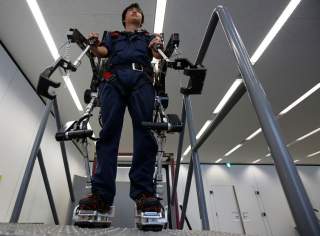The Future Is Nigh: Army Asks Defense Companies for Powered Exoskeletons
High-tech warfare marches onward.
The Army seeks to assess the state of the U.S. market of sustainment-type exoskeleton approaches to improve soldier performance during repetitive logistics and sustainment load tasks.
NATICK, Mass. – U.S. Army researchers are surveying to determine the state of the art in powered exoskeleton technology to enable warfighters to move quickly and improve their endurance on the battlefield, lift and carry heavy loads, and help with resupply efforts.
Officials of the Soldier Center of the Army Combat Capabilities Development Command soldier Center in Natick, Mass., issued a request for information (W911QY19REXOS) on Wednesday for the Exoskeleton Technologies For The Warfighter project.
Army researchers want industry white papers on available technologies that could help soldiers with high-stress and high-fatigue tasks like heavy and repetitive lifting, combat, mission support, and related jobs.
White papers will help Army researchers learn the state of art in powered exoskeleton technology and match the current warfighting performance against what soldiers in the field need today.
A powered exoskeleton is a wearable mobile machine that is powered by electric motors, pneumatics, levers, and hydraulics that enable limb movement with increased strength and endurance.
The Army must make the brigade combat team (BCT) leaner while retaining capability, preventing overmatch, and setting the conditions for fundamental change by advancing human physical performance augmentation such as wearable load-bearing assistance technologies and exoskeletons, officials say.
The Army seeks to assess the state of the U.S. market of sustainment-type exoskeleton approaches to improve soldier performance during repetitive logistics and sustainment load tasks.
These tasks include heavy and repetitive supply lifting, loading, unloading, and transporting water, food, and ammunition. Key focuses are strength assist, throughput, and productivity augmentation -- including customized effectors based on lift, move, and carry tasks.
Powered exoskeletons must exhibit user safety, comfort, ease of use, energy efficiency, cost effectiveness, and system compatibility with soldier, mission, clothing, and mission equipment. Army researchers are interested most in exoskeletons under evaluation today.
Papers should include a brief technical description of the system, the type of environment, tasks it is best suited for, the length of time that it has been under evaluation, user feedback, and the technical point of contact for the project.
The Army is interested in exoskeleton types that could support logistics and sustainment; light tasks; medium-lift and carry; heavy-lift and carry; situational awareness, lethality, explosive ordnance disposal, and chemical and biological protection; aircraft and vehicle maintenance; and construction jobs like digging, building bridges and structures, and moving equipment.
No non-U.S. exoskeletons will be considered.
This article by John Keller originally appeared on Military & Aerospace Electronics in 2019.
Image: Reuters.

